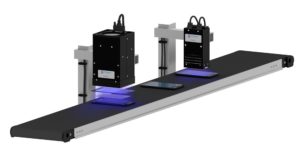UV LED curing technology offers lower operating costs than traditional technologies, as well as long lifetime, enhanced system capabilities, and environmental benefits.
Ultraviolet (UV) light-emitting diode (LED) curing technology has been adopted for adhesive bonding, sealant, and coating processes in factory assembly lines throughout the world. Adhesive chemistries that have been adapted to the UV function to enhance curing, handling, and user control include: acrylate/urethanes, cyanoacrylates, silicones, anaerobics, pressure- sensitive adhesives, film adhesives, and epoxies.
UV LED curing technology offers lower operating costs, long lifetime, enhanced system capabilities due to being a solid-state device, and environmental benefits associated with safer workplace environments. In addition, UV LED provides a low- temperature light source for small components that may be sensitive to heat.
‘LED technology minimizes the heat load to the work surface, allowing for capability with heat-sensitive applications. ‘
Phoseon Technology
Understanding UV Curing
UV curing is a photopolymerization process that uses UV energy to change a liquid to a solid. Upon absorption of the UV energy, the photoinitiator (PI) produces free radicals that initiate crosslinking with binders (monomers and oligomers) in a polymerization reaction to cure or solidify the coating or adhesive, usually in a few seconds.
Industrial sources of UV energy have long included medium- pressure mercury arc and microwave-powered lamps, as well as the more recent LEDs. All three technologies are used to crosslink inks, coatings, and adhesives in a wide range of manufacturing processes. Both arc and microwave curing technologies rely on the vaporization of mercury within a sealed quartz tube containing an inert gas mixture. Mercury lamps require toxic mercury disposal and produce ozone gas that needs to be extracted by ventilation.
UV LEDs are solid-state semiconductors. UV LED generates UV energy by applying an electric current to a semiconductor device called a diode, causing it to emit UV energy. The specific materials in the diode determine the wavelengths of the output, which is typically in a very narrow band ± 10 nm.
To achieve efficient and effective UV curing of an adhesive or coating, the formulator seeks to match the UV lamp spectral output with the absorption characteristics of the photoinitiators used in the formulation. Since current- generation UV LED emission wavelengths are strongest at 365 and 395 nm, photoinitiators and other formulation components should be selected to allow efficient excitation of the photoinitiators at those wavelengths.
Benefits
UV LED curing embraces many of the advantages of traditional UV curing for manufacturing processes, offering advanced capabilities beyond traditional mercury UV curing. First, UV LEDs do not generate any infrared output that is translated into heat. This is extremely important on manufacturing lines where the introduction of heat changes the chemical properties of the adhesive or coating. In these cases, heat can lead to material warping, lack of adhesion, and eventually scrap. UV LEDs are a “cool” light source; the only heat involved is due to UV energy being generated. The second major improvement is process stability. Manufacturing companies need consistent, stable output. Traditional UV bulbs degrade over time, which means their UV output was not keep stable. UV LED provides stable UV output consistently over time, leading to better process control and stability.
Applications
UV LED curing technology is ideally suited for electronic assembly applications. The combination of high-energy UV LED sources with the appropriate adhesive enables increased productivity while also providing the ability to cure heat-sensitive materials. Many electronics manufacturers utilize UV LED curing in the production of products such as touchscreens, mobile phones, micro-speakers, and hard disk drives.
Tags: ASI Magazine | UV LED Curing for Adhesives, Sealants and Coatings | UV LED Industrial Curing | UV LED TechnologyCategories: Adhesives | Coatings
